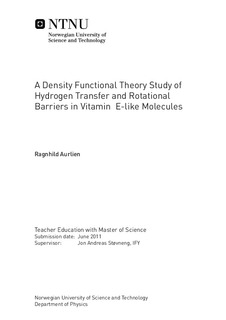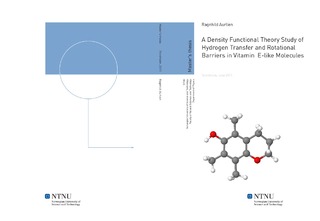| dc.description.abstract | A study of the antioxidant property of two vitamin E simplifications with density functional theory has been done. In one of the simplifications the phytyl tail and the methyl group on the heterocyclic ring in vitamin E is replaced by two hydrogen atoms, simplification A. In the other simplification the heterocyclic ring is replaced by two hydrogen atoms, simplification B. Three main investigations have been done; rotation of the hydroxyl group on the different isoforms of the two simplifications, hydrogen transfers from the alpha-isoform of the simplifications to three different radicals OOH, OOCH3, and OOC2H5, and a rotation of the hydroxyl group with a hydrogen bond to OOH and OOCH3 for simplification B. The BLYP exchange correlation functional is found to underestimate hydrogen transfer energy barriers, which is improved with the B3LYP functional. This problem did not occur for the rotation of the hydroxyl group. The energy barriers for the rotation of the hydroxyl group is found to be smallest for the alpha-isoform, and simplification A gives lower rotational barriers than simplification B. Simplification A also results in smaller energy barriers for hydrogen transfers. The hydrogen transfer to OOC2H5 with the B3LYP functional resulted in hydrogen barriers of 0,411 eV for simplification B and 0,231 eV for simplification A. Thus simplification B is found to be less reactive than simplification A, which is explained by the electron donating property of the heterocyclic ring not included in simplification B. Since simplification B is less reactive than simplification A, it is concluded to be a poorer antioxidant than simplification A, and a poor model for vitamin E. | nb_NO |

